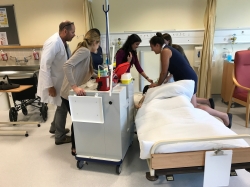“I cannot wait to be a nurse” … Irish experience excites student about their chosen profession

After eight class sessions on Irish healthcare and culture throughout the spring 2017 semester, six nursing students – sophomores and juniors accompanied by Maryanne V. Lieb MSN, RN, clinical assistant professor and Tamara M. Kear PhD, RN, CNS, CNN, associate professor – visited Ireland May 13 – 27 for an International Field Study in Nursing. Aside from growing in their cultural sensitivity and understanding of similarities and differences in the U.S. and Irish health care systems, they saw the universality of nursing.
During the first week, they attended classes at the National University of Ireland, Galway (NUIG) in the Department of Nursing and Midwifery Studies. Classes were taught by several members of the faculty, all of whom were engaging and inspiring. The content of the classes illustrated the commonalities of nursing while pointing out differences in Ireland.
The various specialty areas of nursing appealed to different students within the group and included the discussion of end of life issues, health care disparities, midwifery, acute care, nursing in the community, and mental health nursing. The group heard a firsthand perspective from a young man with a history of mental illness who was treated in the Irish health care system and now speaks with communities and health care professionals for the purpose of promoting change where needed and encouraging effective treatment modalities. He also composes music and performed one of his songs for them.

One of the highlights of the sessions at NUIG was the interactive simulation the faculty presented of a cardiac arrest. The NUIG faculty assumed the roles of physician, anesthesiologist, and patient wife. Each student had a role to play, including performing CPR, communicating with the physician, completing documentation, and comforting the patient’s wife. Everyone participated in a debriefing after the simulation concluded and discussed what needed to be done as the scenario unfolded, what they would have done differently, and what went well.

Students also attended a research day/science fair for grade school children that the University offered. They worked on a research project of their own that was presented along with various other projects and studies of interest. Additionally, the group met “Mario” and learned about the benefits this robot could have assisting an individual living alone who has early dementia.
The students and faculty were provided a brief tour of the University Hospital by two of the University’s Clinical Coordinators. They walked through several units including the Intensive Care Unit, the Cardio-thoracic unit and a step down unit to further enhance their understanding of Irish healthcare.
On the last day of their time at the University, the students presented two 20 minute PowerPoint presentations which they had prepared ahead of time to share with the faculty. The topics were: Life as a Villanova nursing student and Service learning opportunities at Villanova University. The students also articulated their gratefulness to the faculty at NUIG for sharing their information, research and experiences but most of all for their genuine kindness and welcome. The NUIG faculty commented on how impressed they were with the students’ professionalism and their ability to articulate their thoughts and impressions so eloquently.
Following the academic experiences and parallel exploration of Galway, the group toured more of Ireland, including the Aran Islands, Cork and Dublin.
“I cannot wait to be a nurse. I learned more about specific fields and the plethora of things you can do with a nursing degree. The most significant learning I gained was the realization that I chose the right career,” notes one student, adding “Nursing is very universal, which is comforting to me because everyone is on the same page when it comes to the care of the human being. But based on some culture changes, there are subtle differences that make the profession unique to the individual.”
